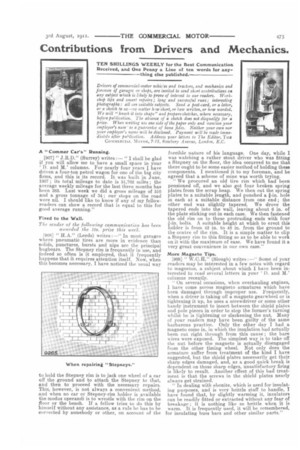Contributions from Drivers and Mechanics.
Page 21

If you've noticed an error in this article please click here to report it so we can fix it.
TEN SHILLINGS WEEKLY for the Best Communication Received, and One Penny a Line of ten words for any thing else published
Drivers of commercial-motor vehicles and tractors, and mechanics and foremen of garages or shops, are invited to send short contributions on any subject which is likely to prove of interest to our readers. Workshop tips and smart repairs ; long and successful runs ; interesting photographs: all are suitable subjects. Send a post-card, or a letter, Or a sketch to us—no matter low short, or bow written, or how worded. We will "knock it into shape" and prepare sketches, where necessary, before publication. The absence of a sketch does not disqualify for a prize. When writing use one side of the paper only and inesation your employer's tramAS a guarantee of bona fides. Neither your own nor your employer's name will be disclosed. Payment will be made immediately after publication. Address your letters to The Editor, T/Ig CoMMERCIAT. Ma YOR, 7-15, Rosebery AVenue, London, E.G.
A "Commer Car's" Running, [907] " J.R.D." (Surrey) writes :— " I shall be glad if you will allow me to have a small space in your D. and M.' columns. For nearly four years I have driven a four-ton petrol wagon for one of the big city firms, and this is its record. It, was built in June, 1907; its total mileage to date is 51,762 miles ; the average weekly mileage for the last three months has been 383. Last week we did a gross mileage of 510 and a gross tonnage of ; our stops on the road were nil. I should like to know if any of my fellowreaders can show a record that is equal to this for good average running."
Fixed to the Wall.
The sender of the fallowing communication has been awarded the 10s. prize th-is week.
1908] " ILA." (Leeds) writes :—" In most garages where pneumatic tires are more in evidence than solids, punctures, bursts and nips are the principal bugbears. The Stepney rim is frequently in use, and indeed so often is it employed, that it frequently happens that it requires attention itself. Now, when this becomes necessary, I have noticed the usual way
to hold the Stepney rim is to jack one wheel of a car off the ground and to attach the Stepney to that, and then to proceed with the necessary repairs. This, however, is not always a convenient method, and when no car or Stepney-rim holder is available the modus operandi is to wrestle with the rim on the floor or the bench. If a fellow tries to do this by himself without any assistance, as a rule he has to be corrected by somebody or other, on account of the
forcible nature of his language. One day, while I was watching a rather stout driver who was fitting a Stepney on the floor, the idea occurred to me that there ought to be some easier method of holding these components. I mentioned it to my foreman, and he agreed that a scheme of mine was worth trying.
We procured an old tire rim which had been pensioned off, and we also got four broken spring plates from the scrap heap. We then cut the spring plates to a suitable length, and punched a i-in. hole in each at a suitable distance from one end ; the other end was slightly tapered. We drove the tapered ends into the wall, leaving about 6 in. of the plate sticking out in each case. We then fastened the old rim on to these protruding ends with four On. bolts. A suitable height at which to erect this holder is from 42 in. to 48 in. from the ground to the centre of the rim. It is a simple matter to clip a Stepney rim to this fitting so as to be able to work on it with the maximum of ease. We have found it a very great convenience in our own case."
More Magneto Tips.
£909] " W.C.I1." (Slough) writes :—" Some of your readers may be interested in a few notes with regard to magnetos, a subject about which I have been interested to read several letters in your D. and M.' columns recently. " On several occasions, when overhauling engines, I have come across magneto armatures which have been damaged through improper use. Frequently, when a driver is taking off a magneto gearwheel or is tightening it up, he uses a screwdriver or some other handy instrument to insert between the shield plates and pole pieces in order to stop the former's turning whilst he is tightening or slackening the nut. Many of your readers may have been guilty of the same barbarous practice. Only the other day I had a magneto come in, in which the insulation had actually been cut right through from this cause ; the bare wires were exposed. The simplest way is to take off the nut before the magneto is actually disengaged from the other timing wheel. Not only does the armature suffer from treatment of the kind I have suggested, but the shield plates necessarily get their sharp edges damaged, and, as a good quick break is dependent on those sharp edges, unsatisfactory firing is likely to result. Another effect of this bad treatment is that the screws in the shield plates nearly always get strained. " In dealing with ebonite, which is used for insulating purposes, and is very brittle stuff to handle, I have found that, by slightly warming it, insulators can be readily fitted or extracted without any fear of breakage ; it is nothing like so brittle when it is warm. It is frequently used, it will be remembered, for insulating buss bars and other similar parts."






















